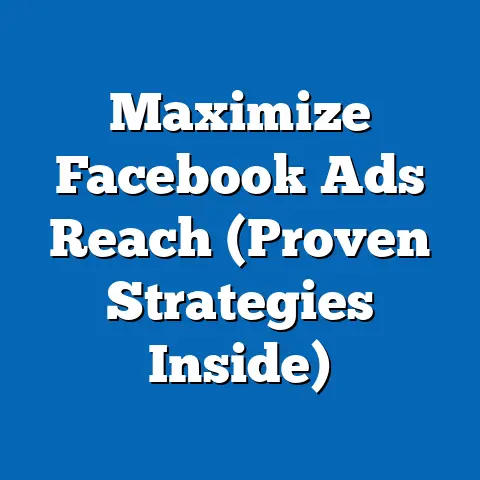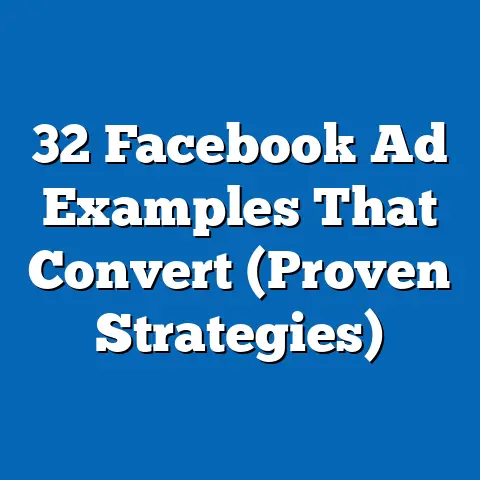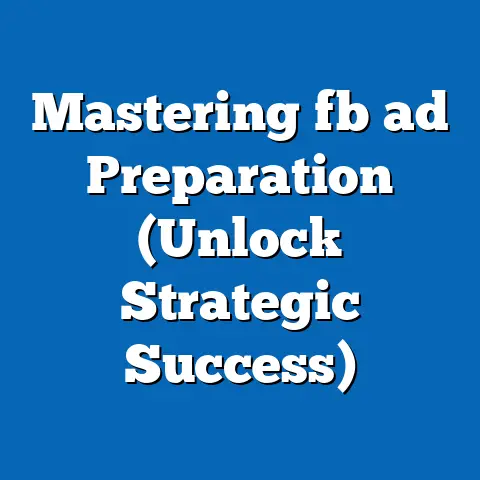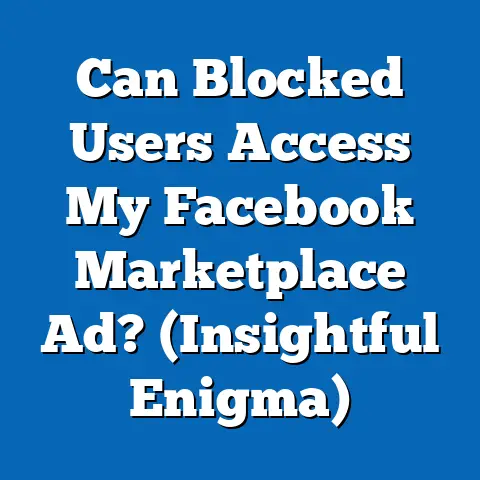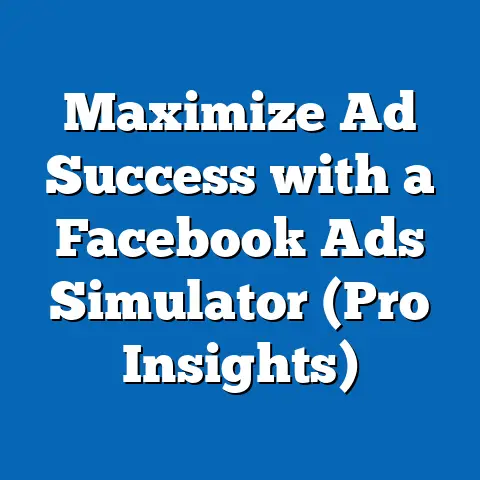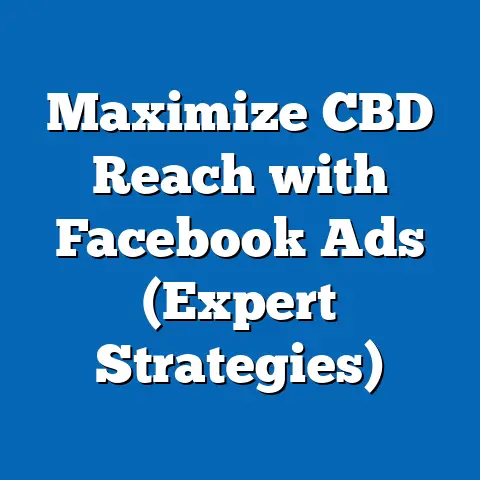Unlocking Facebook Winner Ads: Secrets to Success (Pro Tips)
Facebook advertising. Just the name can evoke feelings of excitement, frustration, and maybe a little bit of overwhelm. I get it. I’ve been there. I remember when I first started delving into Facebook ads, it felt like navigating a labyrinth. But, trust me, the potential payoff is HUGE. In today’s digital marketing landscape, mastering Facebook ads is no longer optional; it’s essential for driving traffic, generating leads, and boosting sales.
Think about it: billions of people use Facebook daily. That’s a massive audience, and with the right strategy, you can tap into it to reach your ideal customers. That’s why I’m excited to share these key secrets and pro tips that will help you craft winning Facebook ads. Let’s transform that feeling of overwhelm into confidence and turn those ads into revenue-generating machines!
Safety First: Understanding Facebook’s Ad Policies
Before we dive into the exciting world of crafting compelling ads, let’s talk about something crucial: playing by the rules. Facebook’s advertising policies are like the foundation upon which all successful campaigns are built. Ignoring them is like building a house on sand – it might look good at first, but it won’t last.
I’ve seen firsthand how quickly an ad can get rejected or, worse, an entire account suspended for violating these policies. Trust me, it’s not a fun experience. Imagine spending hours crafting the perfect ad, only to have it immediately disapproved!
Common Violations to Watch Out For:
- Misleading Content: This is a big one. Don’t make false claims or exaggerate the benefits of your product or service. Transparency is key.
- Inappropriate Images: Avoid using shocking, graphic, or sexually suggestive imagery. Facebook wants to maintain a positive user experience.
- Offensive Language: This should be a no-brainer, but avoid using profanity, hate speech, or discriminatory language in your ads.
- Personal Attributes: You can’t directly reference a person’s race, ethnicity, religion, age, sexual orientation, or other personal attributes. For example, saying “Are you over 50 and looking for insurance?” is a big no-no.
- Health Claims: Be very careful when making health claims. You’ll likely need to provide supporting documentation to Facebook.
- Before-and-After Photos: These can be tricky. Make sure your claims are realistic and not misleading.
Real-World Example:
I once worked with a client who was selling a weight loss supplement. They created an ad with a dramatic before-and-after photo and claimed that users could lose 20 pounds in a week. The ad was immediately rejected because it made unrealistic promises and violated Facebook’s health claims policy.
User Privacy and Data Security:
Facebook takes user privacy very seriously, and so should you. Make sure you’re complying with all relevant data privacy laws, such as GDPR and CCPA. Be transparent about how you collect and use user data, and always provide users with the option to opt out.
Takeaway:
Understanding and adhering to Facebook’s advertising policies is non-negotiable. It’s the first step towards creating successful and sustainable ad campaigns. Take the time to familiarize yourself with the guidelines, and always err on the side of caution. Trust me, it’s better to be safe than sorry!
Next Step:
Head over to Facebook’s Advertising Policies page and give it a thorough read. Make sure you understand the rules before you start creating your ads.
Understanding Your Audience
Okay, so you know the rules of the game. Now, let’s get to the heart of successful Facebook advertising: understanding your audience. This isn’t just about knowing their age and gender. It’s about digging deep and understanding their motivations, their pain points, their desires, and their online behavior.
I like to think of it as becoming a detective, uncovering clues that will help you craft ads that truly resonate with your target audience.
Why Audience Segmentation Matters:
Imagine trying to sell snow shovels to people living in Florida. It’s not going to work, right? The same principle applies to Facebook advertising. If you’re showing the wrong ads to the wrong people, you’re wasting your time and money.
Tools for Audience Insights:
- Facebook Audience Insights: This tool provides valuable data about your target audience, including their demographics, interests, behaviors, and page likes. It’s like having a peek inside their Facebook profile.
- Custom Audiences: This allows you to upload your own customer data (e.g., email addresses, phone numbers) and target those specific individuals on Facebook. It’s perfect for retargeting existing customers or reaching out to potential leads.
- Lookalike Audiences: This is where things get really powerful. You can create a “lookalike” audience based on your existing customer data. Facebook will find users who share similar characteristics and behaviors, expanding your reach to new potential customers.
Creating Detailed Buyer Personas:
I always recommend creating detailed buyer personas for each of your target segments. A buyer persona is a fictional representation of your ideal customer. Give them a name, a backstory, and a personality. What are their goals? What are their challenges? What motivates them?
Example:
Let’s say you’re selling organic skincare products. Your buyer persona might be “Sarah,” a 35-year-old working mom who’s concerned about the ingredients in her skincare products and wants to find natural alternatives. She’s active on social media, follows eco-conscious brands, and values sustainability.
Retargeting Strategies:
Retargeting is one of the most effective ways to boost your ad performance. It involves showing ads to people who have already interacted with your business in some way, such as visiting your website, watching a video, or engaging with your Facebook page.
Takeaway:
Understanding your audience is the foundation of successful Facebook advertising. The more you know about your target audience, the better you’ll be able to craft ads that resonate with them and drive results.
Next Step:
Start using Facebook Audience Insights to research your target audience. Create detailed buyer personas for each of your target segments. Set up retargeting campaigns to reach people who have already interacted with your business.
Now, it’s time to talk about the words that will grab their attention and persuade them to take action: your ad copy. I’ve seen some incredibly well-designed ads fall flat because the copy was weak. Don’t let that happen to you!Elements of Effective Ad Copy:
- Clarity: Your message should be clear, concise, and easy to understand. Avoid jargon or technical terms that your audience might not be familiar with.
- Conciseness: Get to the point quickly. People are scrolling through their news feeds at lightning speed, so you need to grab their attention immediately.
- Emotional Appeal: Connect with your audience on an emotional level. What are their pain points? What are their desires? Use your copy to address those emotions.
The AIDA Model:
The AIDA model (Attention, Interest, Desire, Action) is a classic marketing framework that can be incredibly helpful when writing ad copy.
- Attention: Grab the reader’s attention with a compelling headline or opening line.
- Interest: Generate interest by highlighting the benefits of your product or service.
- Desire: Create desire by showing how your product or service can solve their problems or fulfill their needs.
- Action: Tell the reader what you want them to do (e.g., “Shop Now,” “Learn More,” “Sign Up”).
Examples of High-Performing Ad Copy:
Let’s break down a few examples:
-
Example 1: A local coffee shop promoting their new seasonal latte.
- Headline: “Fall is in the air… and in our lattes! 🍂”
- Body: “Cozy up with our new Pumpkin Spice Latte, made with real pumpkin and a hint of cinnamon. Available for a limited time only!”
- Call to Action: “Visit us today and get your fall fix! ☕”
-
Example 2: An online clothing store promoting a sale.
-
Headline: “🚨 HUGE SALE! Up to 70% Off! 🚨”
- Body: “Don’t miss out on our biggest sale of the year! Get up to 70% off all your favorite styles. Shop now before it’s too late!”
- Call to Action: “Shop Now and Save! 🛍️”
Example 1: A local coffee shop promoting their new seasonal latte.
- Headline: “Fall is in the air… and in our lattes! 🍂”
- Body: “Cozy up with our new Pumpkin Spice Latte, made with real pumpkin and a hint of cinnamon. Available for a limited time only!”
- Call to Action: “Visit us today and get your fall fix! ☕”
-
Example 2: An online clothing store promoting a sale.
-
Headline: “🚨 HUGE SALE! Up to 70% Off! 🚨”
- Body: “Don’t miss out on our biggest sale of the year! Get up to 70% off all your favorite styles. Shop now before it’s too late!”
- Call to Action: “Shop Now and Save! 🛍️”
Example 2: An online clothing store promoting a sale.
Headline: “🚨 HUGE SALE! Up to 70% Off! 🚨”
Tips for Strong Calls to Action:
- Use Action Verbs: Start your CTA with a strong action verb, such as “Shop,” “Learn,” “Sign Up,” or “Download.”
- Create a Sense of Urgency: Use words like “Now,” “Today,” or “Limited Time Only” to encourage people to take action immediately.
- Make it Clear and Concise: Your CTA should be easy to understand and tell people exactly what you want them to do.
Takeaway:
Compelling ad copy is essential for capturing attention, generating interest, and driving action. Use clear, concise, and emotionally appealing language to connect with your audience and persuade them to click on your ad.
Next Step:
Start brainstorming ad copy ideas for your target audience. Use the AIDA model as a framework, and focus on highlighting the benefits of your product or service. Experiment with different CTAs to see which ones perform best.
Visuals Matter: Designing Eye-Catching Ads
Okay, so you’ve got killer ad copy, but let’s be honest, on Facebook, visuals are king. People are visual creatures, and they’re much more likely to stop scrolling if they see something that catches their eye. I can’t stress enough how important it is to invest in high-quality visuals for your Facebook ads.
The Role of Visuals:
- Capture Attention: A compelling visual can stop people in their tracks and make them pay attention to your ad.
- Enhance Engagement: Visuals can make your ad more engaging and encourage people to like, comment, and share.
- Communicate Your Message: Visuals can help you communicate your message more effectively, especially if you’re selling a product or service that’s difficult to describe in words.
Ad Formats on Facebook:
- Image Ads: These are the simplest type of ad, consisting of a single image and some text.
- Video Ads: Video ads are incredibly engaging and can be used to tell a story, demonstrate a product, or share a testimonial.
- Carousel Ads: Carousel ads allow you to showcase multiple images or videos in a single ad. They’re great for highlighting different features of a product or service.
- Slideshow Ads: Slideshow ads are similar to video ads, but they’re made up of a series of still images. They’re a great way to create a dynamic ad without the expense of producing a video.
Best Practices for Designing Visuals:
- Align with Brand Identity: Your visuals should be consistent with your brand’s overall look and feel. Use your brand colors, fonts, and imagery.
- Stand Out in the News Feed: Use bright colors, bold typography, and eye-catching images to make your ad stand out from the crowd.
- Use High-Quality Images: Avoid using blurry, pixelated, or low-resolution images. Invest in professional photography or use high-quality stock photos.
- Consider Color Psychology: Colors can evoke different emotions, so choose colors that are appropriate for your brand and message.
- Test Different Visuals: Experiment with different images, videos, and ad formats to see which ones resonate best with your target audience.
Takeaway:
Visuals are a critical component of successful Facebook advertising. Invest in high-quality visuals that align with your brand identity, stand out in the news feed, and effectively communicate your message.
Next Step:
Start experimenting with different ad formats and visuals. Use A/B testing to see which ones perform best with your target audience. Pay attention to color psychology and choose colors that evoke the desired emotions.
Utilizing Facebook Ad Tools and Features
You’ve got your audience, your ad copy, and your visuals all dialed in. Now, it’s time to talk about the tools and features that Facebook provides to help you manage and optimize your ad campaigns. These tools are like the control panel of your Facebook advertising spaceship. Mastering them is essential for achieving maximum effectiveness.
Essential Facebook Ad Tools:
- Ads Manager: This is your central hub for creating, managing, and tracking your Facebook ad campaigns. It’s where you’ll set your budget, choose your targeting options, and monitor your performance metrics.
- Facebook Pixel: This is a small piece of code that you install on your website. It allows you to track conversions, retarget website visitors, and optimize your ads for specific actions.
- Dynamic Ads: These ads automatically show the most relevant products to each user based on their browsing behavior. They’re perfect for e-commerce businesses looking to personalize their advertising.
Setting Up and Optimizing Ad Campaigns:
- Define Your Goals: What do you want to achieve with your Facebook ads? Are you trying to generate leads, drive website traffic, or increase sales? Define your goals before you start creating your campaigns.
- Choose the Right Objective: Facebook offers a variety of advertising objectives, such as Brand Awareness, Reach, Traffic, Engagement, Leads, and Conversions. Choose the objective that aligns with your goals.
- Set Your Budget: Decide how much you’re willing to spend on your ad campaigns. You can set a daily budget or a lifetime budget.
- Choose Your Targeting Options: Use Facebook’s targeting options to reach your ideal audience. You can target based on demographics, interests, behaviors, and more.
- Monitor Your Performance: Keep a close eye on your performance metrics, such as click-through rates, conversion rates, and return on ad spend. Use this data to optimize your campaigns and improve your results.
A/B Testing:
A/B testing (also known as split testing) is a powerful technique for refining your ads based on performance data. It involves creating two or more versions of an ad with slight variations (e.g., different headlines, images, or CTAs) and then testing them against each other to see which one performs best.
Automated Rules:
Facebook’s automated rules allow you to automatically manage your ad performance and budget adjustments based on predefined criteria. For example, you can create a rule that automatically pauses an ad if its cost per click exceeds a certain threshold.
Takeaway:
Facebook offers a wealth of tools and features to help you manage and optimize your ad campaigns. Take the time to learn how to use these tools effectively, and you’ll be well on your way to achieving your advertising goals.
Next Step:
Familiarize yourself with Facebook Ads Manager, the Facebook Pixel, and dynamic ads. Start experimenting with A/B testing to refine your ads based on performance data. Set up automated rules to manage your ad performance and budget adjustments.
Analyzing Performance Metrics
You’ve launched your Facebook ad campaigns, and the data is rolling in. But what does it all mean? Understanding your performance metrics is crucial for determining whether your ads are working and how you can improve them. It’s like reading the gauges in your advertising spaceship to make sure you’re on the right course.
Key Performance Indicators (KPIs):
- Click-Through Rate (CTR): This is the percentage of people who saw your ad and clicked on it. A high CTR indicates that your ad is relevant and engaging to your target audience.
- Conversion Rate: This is the percentage of people who clicked on your ad and then completed a desired action, such as making a purchase, signing up for a newsletter, or filling out a form.
- Cost Per Click (CPC): This is the amount you pay each time someone clicks on your ad.
- Cost Per Acquisition (CPA): This is the amount you pay for each conversion.
- Return on Ad Spend (ROAS): This is the amount of revenue you generate for every dollar you spend on advertising.
Interpreting the Data:
- Low CTR: This could indicate that your ad copy or visuals aren’t compelling enough, or that you’re targeting the wrong audience.
- Low Conversion Rate: This could indicate that your landing page is not optimized for conversions, or that your offer is not appealing enough.
- High CPC: This could indicate that your ad is not relevant enough to your target audience, or that you’re bidding too high.
- Low ROAS: This could indicate that you’re spending too much on advertising or that your product or service is not profitable enough.
Creating a Reporting Dashboard:
I highly recommend creating a reporting dashboard to track your ad performance over time and identify trends. This will allow you to see at a glance how your campaigns are performing and make informed decisions about how to optimize them.
Takeaway:
Analyzing your performance metrics is essential for determining whether your Facebook ads are working and how you can improve them. Pay attention to your KPIs, interpret the data, and create a reporting dashboard to track your performance over time.
Next Step:
Start tracking your performance metrics in a spreadsheet or reporting dashboard. Analyze the data to identify areas for improvement. Experiment with different ad copy, visuals, and targeting options to see which ones perform best.
Staying Ahead of Trends and Changes
The world of Facebook advertising is constantly evolving. Algorithm changes, new features, and emerging trends in consumer behavior can all impact your ad performance. It’s crucial to stay informed and adapt to these changes to maintain a competitive edge.
Resources for Ongoing Learning:
- Facebook’s Business Blog: This blog provides valuable insights and tips on Facebook advertising, as well as updates on new features and algorithm changes.
- Industry Webinars: Attend industry webinars to learn from experts and stay up-to-date on the latest trends in Facebook advertising.
- Marketing Communities: Join online marketing communities to connect with other advertisers, share tips, and ask questions.
- Facebook Blueprint: This is Facebook’s official e-learning platform where you can take courses and earn certifications to enhance your knowledge and skills in Facebook advertising.
Experimentation is Key:
Don’t be afraid to experiment with new strategies and tactics. The best way to stay ahead of the curve is to continuously test new approaches and see what works best for your business.
Takeaway:
Staying current with Facebook’s evolving advertising landscape is essential for maintaining a competitive edge. Use the resources mentioned above to stay informed, and don’t be afraid to experiment with new strategies and tactics.
Next Step:
Subscribe to Facebook’s Business Blog. Attend industry webinars. Join online marketing communities. Start experimenting with new strategies and tactics in your Facebook ad campaigns.
Conclusion
So, there you have it – my top secrets and pro tips for unlocking Facebook winner ads. We’ve covered a lot of ground, from understanding Facebook’s ad policies to crafting compelling copy and analyzing performance metrics.
Remember, the key to success is to stay safe, understand your audience, create compelling ads, and continuously learn and adapt.
Now, it’s time to put these pro tips into action! I’m confident that if you follow these guidelines, you’ll be well on your way to unlocking your own Facebook winner ads and achieving greater marketing success. Go forth and conquer the Facebook advertising world!

